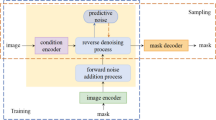Abstract
While denoising 3D MRI, structural preservation is a very critical process in the medical region. However, Rician noise in MRI has affected the image quality which is complicated for diagnosing the disease like a brain tumor. So the Rician noise removal process is introduced in this article using filters based method named Residual Encoder-Decoder Up-sampling Non-Similar Wassertein Generative Adversarial Network (REDUPNSWGAN) which preserves the structural similarity between the neighbor-hood slices in 3D configuration is utilized as GPU. Residual auto-encoders are connected with De-convolution processes that are sent to the Generator Net (GNET). Furthermore, to reduce the level of Huber loss, the perceptual loss for similarity is implemented by the extraction of the feature space using Average-pool Net (AVGNET) which is incorporated with Huber loss, signed structural non-similar loss and Wassertein Adversarial loss to form the REDUPNSWGAN loss. Experimentally, this proposed method shows better performance quality based on mean PSNR than REDWGANVGG19 and also time complexity based on training and testing period which shows better than REDWGANVGG19. Particularly, the proposed network Residual Encoder-Decoder Upsampling Non-Similar REDUPNSWGAN reduces the noise level and preserves the structural similarity.







Similar content being viewed by others
References
Arjovsky, M., Chintala, S., & Bottou, L. (2017, July). Wasserstein generative adversarial networks. In International conference on machine learning (pp. 214-223). PMLR.
Chen, Y., Shi, F., Christodoulou, A. G., Xie, Y., Zhou, Z., & Li, D. (2018, September). Efficient and accurate MRI super-resolution using a generative adversarial network and 3D multi-level densely connected network. In International Conference on Medical Image Computing and Computer-Assisted Intervention (pp. 91-99). Springer, Cham.
Dabov K, Foi A, Katkovnik V, Egiazarian K (2007) Image Denoising by Sparse 3-D Transform-Domain Collaborative Filtering, in Institute Of Electrical And Electronics Engineers Transactions on Image Processing, vol. 16, no. 8, 2080–2095
Dong, C., Loy, C. C., He, K., & Tang, X. (2015). Image super-resolution using deep convolutional networks. IEEE transactions on pattern analysis and machine intelligence, 38(2), 295-307.
Fu Y, Mazur TR, Wu X, Liu S, Chang X, Lu Y, Li HH et al (2018) A novel MRI segmentation method using CNN-based correction network for MRI-guided adaptive radiotherapy. Med Phys 45(11):5129–5137
Girshick R (2015) Fast r-cnn. In Proceedings of the Institute Of Electrical And Electronics Engineers international conference on computer vision pp. 1440–1448
Gulrajani I, Ahmed F, Arjovsky M, Dumoulin V, Courville AC (2017) Improved training of wasserstein gans. In Advances in neural information processing systems pp. 5767–5777
Inam O, Qureshi M, Omer H ,(2019) De-noising multi-coil magnetic resonance imaging using patch-based adaptive filtering in wavelet domain, Appl Magn Reson 1–19
Jiang D, Dou W, Vosters L, Xu X, Sun Y, Tan T (2018) Denoising of 3D magnetic resonance images with multi-channel residual learning of convolutional neural network. Jpn J Radiol 36(9):566–574
Johnson J, Alahi A, Fei-Fei L (2016) Perceptual losses for real-time style transfer and super-resolution, In European conference on computer vision. Springer, Cham, pp 694–711
Lone AH (2019) Analysis and implementation of MRI denoising methods using statistical filtering approach. Global Sci-Tech 11(2):116–121
Lu J, Tian J, Shen L, Jiang Q, Zeng X, Zou Y (2019) Rician Noise Removal via a Learned Dictionary , Math Probl Eng
Pal C, Das P, Chakrabarti A, Ghosh R (2017) Rician noise removal in magnitude MRI images using efficient anisotropic diffusion filtering. Int J Imaging Syst Technol 27(3):248–264
Park E, Cui X, Nguyen THB, Kim H (2019) Presentation Attack Detection Using a Tiny Fully Convolutional Network, in Institute Of Electrical And Electronics Engineers Transactions on Information Forensics and Security, vol. 14, no. 11, 3016–3025
Ran, M., Hu, J., Chen, Y., Chen, H., Sun, H., Zhou, J., & Zhang, Y. (2019). Denoising of 3D magnetic resonance images using a residual encoder–decoder Wasserstein generative adversarial network. Medical image analysis, 55, 165-180.
Rini, C., Perumal, B., & Rajasekaran, M. P. (2019). Eradication of Rician Noise in Orthopedic Knee MR Images Using Local Mean-Based Hybrid Median Filter. In Proceedings of the 2nd International Conference on Data Engineering and Communication Technology (pp. 693-702). Springer, Singapore.
Tolstikhin, I., Bousquet, O., Gelly, S., & Schoelkopf, B. (2017). Wasserstein auto-encoders. arXiv preprint arXiv:1711.01558.
Wang, Q., Zhou, X., Wang, C., Liu, Z., Huang, J., Zhou, Y., ... & Cheng, J. Z. (2019). WGAN-based synthetic minority over-sampling technique: Improving semantic fine-grained classification for lung nodules in CT images. IEEE Access, 7, 18450-18463.
Yahya, A. A., Tan, J., Su, B., Liu, K., & Hadi, A. N. (2019). Image noise reduction based on adaptive thresholding and clustering. Multimedia Tools and Applications, 78(11), 15545-15573.
Zhang L (2015) Image Adaptive Reconstruction Based on Compressive Sensing via CoSaMP, 2nd International Conference on Information Science and Control Engineering, Shanghai, pp. 760–763
Zhang Y-Q, Wu X-J, Li H (2019) Multi-focus Image Fusion Based on Similarity Characteristics, arXiv preprint arXiv:1 912.07959
Zhang, K., Zuo, W., Chen, Y., Meng, D., & Zhang, L. (2017). Beyond a gaussian denoiser: Residual learning of deep cnn for image denoising. IEEE transactions on image processing, 26(7), 3142-3155.
Zhao M, et al. (2020) Super-Resolution of Cardiac Magnetic Resonance Images Using Laplacian Pyramid based on Generative Adversarial Networks, Comput Med Imaging Graph 101698
Funding
No funding was received in support of this work.
Author information
Authors and Affiliations
Corresponding author
Ethics declarations
Conflict of interest
Mrs. D.M. Annie Brighty Christilin declares that he has no conflict of interest. Dr. M. Safish Mary declares that she has no conflict of interest.
Ethical approval
This article does not contain any studies with human participants or animals performed by any of the authors.
Additional information
Publisher’s note
Springer Nature remains neutral with regard to jurisdictional claims in published maps and institutional affiliations.
Rights and permissions
About this article
Cite this article
Christilin, D.M.A.B., Mary, D.S. Residual encoder-decoder up-sampling for structural preservation in noise removal. Multimed Tools Appl 80, 19441–19457 (2021). https://doi.org/10.1007/s11042-021-10582-z
Received:
Revised:
Accepted:
Published:
Issue Date:
DOI: https://doi.org/10.1007/s11042-021-10582-z




